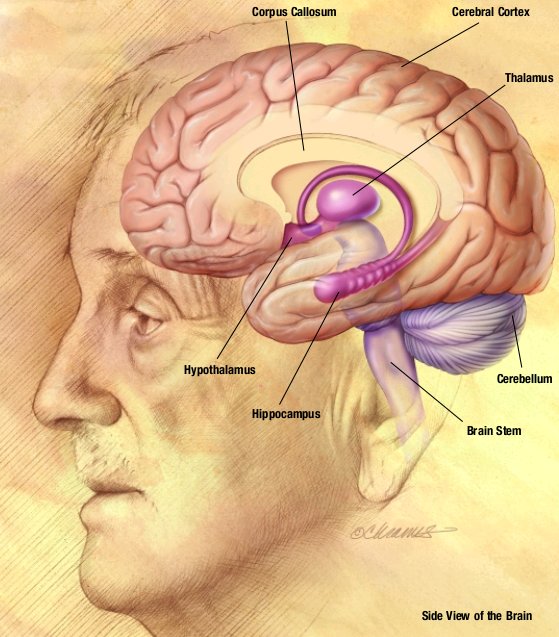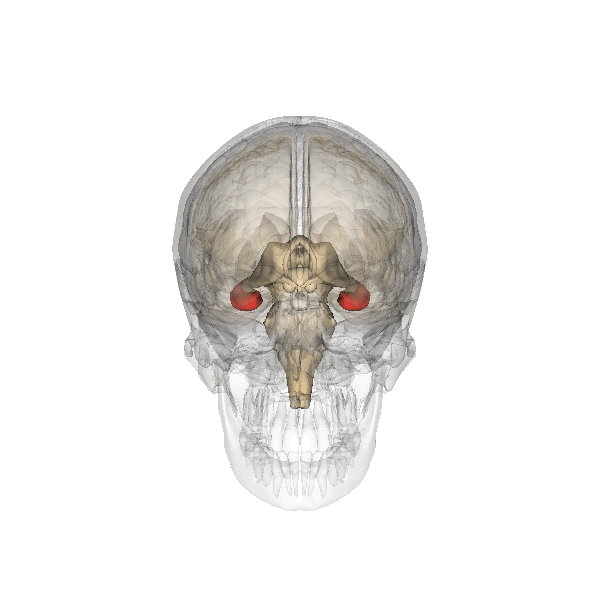|
Neuroanatomy Of Memory
The neuroanatomy of memory encompasses a wide variety of anatomical structures in the brain. Subcortical structures Hippocampus The hippocampus is a structure in the brain that has been associated with various memory functions. It is part of the limbic system, and lies next to the medial temporal lobe. It is made up of two structures, the Ammon's Horn, and the Dentate gyrus, each containing different types of Cell (biology), cells. Cognitive maps There is evidence that the hippocampus contains cognitive maps in humans. In one study, single-cell recordings were taken from electrodes implanted in a rat's hippocampus, and it was found that certain neurons responded strongly only when the rat was in certain locations. These cells are called place cells, and collections of these cells can be considered to be mental maps. Individual place cells do not only respond to one unique area only however, the patterns of activation of these cells overlap to form layered mental maps within ... [...More Info...] [...Related Items...] OR: [Wikipedia] [Google] [Baidu] |
Brain
The brain is an organ (biology), organ that serves as the center of the nervous system in all vertebrate and most invertebrate animals. It consists of nervous tissue and is typically located in the head (cephalization), usually near organs for special senses such as visual perception, vision, hearing, and olfaction. Being the most specialized organ, it is responsible for receiving information from the sensory nervous system, processing that information (thought, cognition, and intelligence) and the coordination of motor control (muscle activity and endocrine system). While invertebrate brains arise from paired segmental ganglia (each of which is only responsible for the respective segmentation (biology), body segment) of the ventral nerve cord, vertebrate brains develop axially from the midline dorsal nerve cord as a brain vesicle, vesicular enlargement at the rostral (anatomical term), rostral end of the neural tube, with centralized control over all body segments. All vertebr ... [...More Info...] [...Related Items...] OR: [Wikipedia] [Google] [Baidu] |
Brain Bulbar Region
The brain is an organ that serves as the center of the nervous system in all vertebrate and most invertebrate animals. It consists of nervous tissue and is typically located in the head (cephalization), usually near organs for special senses such as vision, hearing, and olfaction. Being the most specialized organ, it is responsible for receiving information from the sensory nervous system, processing that information (thought, cognition, and intelligence) and the coordination of motor control (muscle activity and endocrine system). While invertebrate brains arise from paired segmental ganglia (each of which is only responsible for the respective body segment) of the ventral nerve cord, vertebrate brains develop axially from the midline dorsal nerve cord as a vesicular enlargement at the rostral end of the neural tube, with centralized control over all body segments. All vertebrate brains can be embryonically divided into three parts: the forebrain (prosencephalon, subdivided i ... [...More Info...] [...Related Items...] OR: [Wikipedia] [Google] [Baidu] |
Thalamus
The thalamus (: thalami; from Greek language, Greek Wikt:θάλαμος, θάλαμος, "chamber") is a large mass of gray matter on the lateral wall of the third ventricle forming the wikt:dorsal, dorsal part of the diencephalon (a division of the forebrain). Nerve fibers project out of the thalamus to the cerebral cortex in all directions, known as the thalamocortical radiations, allowing hub (network science), hub-like exchanges of information. It has several functions, such as the relaying of sensory neuron, sensory and motor neuron, motor signals to the cerebral cortex and the regulation of consciousness, sleep, and alertness. Anatomically, the thalami are paramedian symmetrical structures (left and right), within the vertebrate brain, situated between the cerebral cortex and the midbrain. It forms during embryonic development as the main product of the diencephalon, as first recognized by the Swiss embryologist and anatomist Wilhelm His Sr. in 1893. Anatomy The thalami ar ... [...More Info...] [...Related Items...] OR: [Wikipedia] [Google] [Baidu] |
Nucleus (neuroanatomy)
In neuroanatomy, a nucleus (: nuclei) is a cluster of neurons in the central nervous system, located deep within the cerebral hemispheres and brainstem. The neurons in one nucleus usually have roughly similar connections and functions. Nuclei are connected to other nuclei by tracts, the bundles (fascicles) of axons (nerve fibers) extending from the cell bodies. A nucleus is one of the two most common forms of nerve cell organization, the other being layered structures such as the cerebral cortex or cerebellar cortex. In anatomical sections, a nucleus shows up as a region of gray matter, often bordered by white matter. The vertebrate brain contains hundreds of distinguishable nuclei, varying widely in shape and size. A nucleus may itself have a complex internal structure, with multiple types of neurons arranged in clumps (subnuclei) or layers. The term "nucleus" is in some cases used rather loosely, to mean simply an identifiably distinct group of neurons, even if they are sprea ... [...More Info...] [...Related Items...] OR: [Wikipedia] [Google] [Baidu] |
Basal Ganglia
The basal ganglia (BG) or basal nuclei are a group of subcortical Nucleus (neuroanatomy), nuclei found in the brains of vertebrates. In humans and other primates, differences exist, primarily in the division of the globus pallidus into external and internal regions, and in the division of the striatum. Positioned at the base of the forebrain and the top of the midbrain, they have strong connections with the cerebral cortex, thalamus, brainstem and other brain areas. The basal ganglia are associated with a variety of functions, including regulating voluntary motor control, motor movements, procedural memory, procedural learning, habituation, habit formation, conditional learning, eye movements, cognition, and emotion. The main functional components of the basal ganglia include the striatum, consisting of both the dorsal striatum (caudate nucleus and putamen) and the ventral striatum (nucleus accumbens and olfactory tubercle), the globus pallidus, the ventral pallidum, the substa ... [...More Info...] [...Related Items...] OR: [Wikipedia] [Google] [Baidu] |
Basal Ganglia And Related Structures (2)
Basal or basilar is a term meaning ''base'', ''bottom'', or ''minimum''. Science * Basal (anatomy), an anatomical term of location for features associated with the base of an organism or structure * Basal (medicine), a minimal level that is necessary for health or life, such as a minimum insulin dose * Basal (phylogenetics), a relative position in a phylogenetic tree closer to the root Places * Basal, Hungary, a village in Hungary * Basal, Pakistan, a village in the Attock District Other * Basal plate (other) * Basal sliding, the act of a glacier sliding over the bed before it due to meltwater increasing the water pressure underneath the glacier causing it to be lifted from its bed * Basal conglomerate, see conglomerate (geology) Conglomerate () is a sedimentary rock made up of rounded gravel-sized pieces of rock surrounded by finer-grained sediments (such as sand, silt, or clay). The larger fragments within conglomerate are called clasts, while the finer sed ... [...More Info...] [...Related Items...] OR: [Wikipedia] [Google] [Baidu] |
Pavlovian Conditioning
Classical conditioning (also respondent conditioning and Pavlovian conditioning) is a behavioral procedure in which a biologically potent stimulus (e.g. food, a puff of air on the eye, a potential rival) is paired with a neutral stimulus (e.g. the sound of a musical triangle). The term ''classical conditioning'' refers to the process of an automatic, conditioned response that is paired with a specific stimulus. It is essentially equivalent to a signal. The Russian physiologist Ivan Pavlov studied classical conditioning with detailed experiments with dogs, and published the experimental results in 1897. In the study of digestion, Pavlov observed that the experimental dogs salivated when fed red meat. Pavlovian conditioning is distinct from operant conditioning (instrumental conditioning), through which the strength of a voluntary behavior is modified, either by reinforcement or by punishment. However, classical conditioning can affect operant conditioning; classically conditione ... [...More Info...] [...Related Items...] OR: [Wikipedia] [Google] [Baidu] |
Explicit Memory
Explicit memory (or declarative memory) is one of the two main types of long-term human memory, the other of which is implicit memory. Explicit memory is the conscious, intentional recollection of factual information, previous experiences, and concepts. This type of memory is dependent upon three processes: acquisition, consolidation, and retrieval. Explicit memory can be divided into two categories: episodic memory, which stores specific personal experiences, and semantic memory, which stores factual information.Tulving E. 1972. Episodic and semantic memory. In Organization of Memory, ed. E Tulving, W Donaldson, pp. 381–403. New York: Academic Explicit memory requires gradual learning, with multiple presentations of a stimulus and response. The type of knowledge that is stored in explicit memory is called declarative knowledge. Its counterpart, known as implicit memory, refers to memories acquired and used unconsciously, such as skills (e.g. knowing how to get dressed ... [...More Info...] [...Related Items...] OR: [Wikipedia] [Google] [Baidu] |
Transient Global Amnesia
Transient global amnesia (TGA) is a neurological disorder whose key defining characteristic is a temporary but almost total disruption of short-term memory with a range of problems accessing older memories. A person in a state of TGA exhibits no other signs of impaired cognitive functioning but recalls only the last few moments of consciousness and, possibly, a few deeply encoded facts of the individual's past e.g., their childhood, family, or home. Both TGA and anterograde amnesia deal with disruptions of short-term memory. However, a TGA episode generally lasts no more than 2 to 8 hours before the patient returns to normal with the ability to form new memories. Signs and symptoms A person under TGA has almost no capacity to establish new memories, but generally appears otherwise mentally alert and lucid, possessing full knowledge of self-identity and identity of close family, and maintaining intact perceptual skills and a wide repertoire of complex learned behavior. The indivi ... [...More Info...] [...Related Items...] OR: [Wikipedia] [Google] [Baidu] |
Procedural Memory
Procedural memory is a type of implicit memory ( unconscious, long-term memory) which aids the performance of particular types of tasks without conscious awareness of these previous experiences. Procedural memory guides the processes we perform, and most frequently resides below the level of conscious awareness. When needed, procedural memories are automatically retrieved and utilized for execution of the integrated procedures involved in both cognitive and motor skills, from tying shoes, to reading, to flying an airplane. Procedural memories are accessed and used without the need for conscious control or attention. Procedural memory is created through ''procedural learning'', or repeating a complex activity over and over again until all of the relevant neural systems work together to automatically produce the activity. Implicit procedural learning is essential for the development of any motor skill or cognitive activity. History The difference between procedural and declarat ... [...More Info...] [...Related Items...] OR: [Wikipedia] [Google] [Baidu] |





